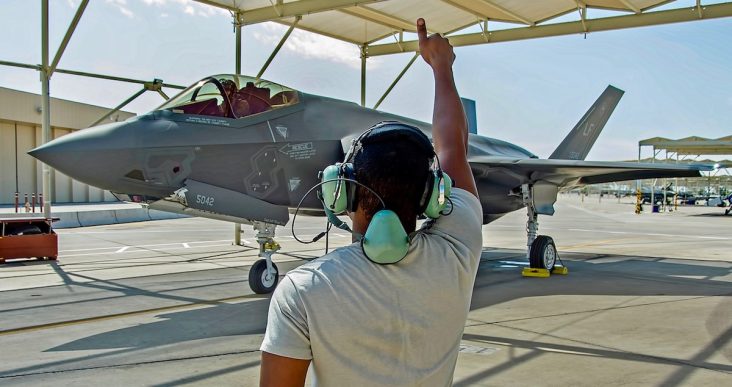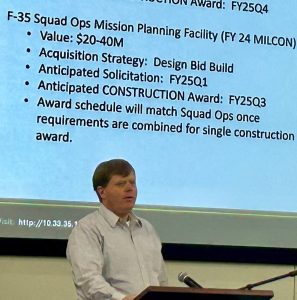Funding, construction pace at foreign pilot training center in Fort Smith ‘real unusual’
by May 3, 2024 10:25 am 3,658 views

F-35 fighter jet
Richard Deaner said the planned pace of work at the Ebbing Air National Guard Base in Fort Smith is “real unusual in today’s environment,” but is needed to ensure the foreign pilot training center is operational in the next 3-4 years.
Deaner, a civilian with the U.S. Army Corps of Engineers who is helping coordinate construction at Ebbing, made the statement during an April 29 Fort Smith Regional Chamber of Commerce event held to connect businesses in the construction and trades industries with civilian and military officials managing construction and other activities involved in setting up the new training center. Aound 200 people attended the event held at the Fort Smith Public School District’s Peak Innovation Center.
Ebbing, home to the 188th Wing in Fort Smith and co-located with the Fort Smith Regional Airport, was selected in March by the U.S. Air Force to be the long-term pilot training center supporting F-16 and F-35 fighter planes purchased by Singapore, Switzerland, Poland, Germany, Finland and other countries participating in the Foreign Military Sales (FMS) program. Singapore also is expected to base 12 F-16s at Ebbing.
Col. George “Ninja” Nichols, with the Air Force Civil Engineering Center, said Ebbing’s footprint is “like a small college campus, with limited real estate, and so we’ve had to come up with some real creative solutions” to build new hangars, training centers, group operations buildings and other facilities for the new training center.
He said much of the estimated $850 million budget to make the center fully operational at Ebbing “will come back to the community in some capacity.”
ESTIMATED CONSTRUCTION SCHEDULE
Deaner said most of the funding for the center will come from at least eight “MilCon” (military construction funds allocated by Congress) rounds in the next 3-4 years. He said the work may include gutting and renovating 6-7 existing base facilities, with the funding levels and pace of work being “real unusual in today’s environment.”

Deaner outlined the following construction schedule with the caveat that planning is ongoing and funding levels and dates could change.
• 3-bay hangar for F-35s
Estimated cost range: $40 million-$60 million
Bids solicited: Second quarter, fiscal year 2025 (Jan.-March 2025)
Contract awarded: Fourth quarter, fiscal year 2025 (July-Sept. 2025)
• Squad Operations Mission Planning Facility – F-35
Estimated cost range: $20 million-$40 million
Bids solicited: First quarter, fiscal year 2025 (Oct.-Dec. 2024)
Contract awarded: Third quarter, fiscal year 2025 (April-June 2025)
• Multi-Country Academic Training Center – F-35
Estimated cost range: $60 million-$90 million
Bids solicited: Second quarter, fiscal year 2025 (Jan.-March 2025)
Contract awarded: Fourth quarter, fiscal year 2025 (July-Sept. 2025)
• Squad Operations – F-35
Estimated cost range: $20 million-$30 million
Bids solicited: Third quarter, fiscal year 2025 (April-June 2025)
Contract awarded: First quarter, fiscal year 2026 (Oct.-Dec. 2025)
• Group Operations – F-35
Estimated cost range: $15 million-$25 million
Bids solicited: First quarter, fiscal year 2026 (Oct.-Dec. 2025)
Contract awarded: Second quarter, fiscal year 2026 (Jan.-March 2026)
• Republic of Singapore Air Force Training Center – F-35
Estimated cost range: $100 million-$150 million
Bids solicited: Fourth quarter, fiscal year 2024 (July-Sept. 2024)
Contract awarded: Third quarter, fiscal year 2026 (April-June 2026)
• Hangar 200 Renovations
Estimated cost range: $50 million-$100 million
Bids solicited: Third quarter, fiscal year 2024 (April-June 2024)
Contract awarded: Fourth quarter, fiscal year 2024 (July-Sept. 2024)
• Republic of Singapore Air Force F-16 facilities renovations
Estimated cost range: $40 million-$80 million
Bids solicited: Fourth quarter, fiscal year 2024 (July-Sept. 2024)
Contract awarded: Fourth quarter, fiscal year 2024 (July-Sept. 2024)
Deaner said other future projects not yet scheduled are likely to include another 3-bay F-35 hangar (estimated cost of $40 million-$60 million), STOVL (short take off and vertical landing) pads (estimated cost $30 million-$40 million), and fuel storage tanks (estimated cost $20 million-$30 million).
ESTIMATED F-35 ARRIVAL SCHEDULE
Lt. Col. Alex “Tuna” Turner, a training officer with the 33rd Fighter Wing at Eglin Air Force Base in Florida, said F-35 planes and pilots from Poland could arrive in September at Eglin to begin initial training. Eglin is the training command that will be the Air Force tenant at Ebbing responsible for the training center.
The Poland planes and pilots could begin training in Fort Smith as early as November. Turner said the full complement of planes from Poland is estimated to arrive in Fort Smith in September 2025, and F-35 pilots and planes from Finland could follow in November. Turner said the Finland training could begin in December.
In June/July 2026, planes and pilots from Singapore and Germany are scheduled to arrive in Fort Smith. Swiss F-35 planes and pilots could arrive in April/May 2027, according to Turner.
Turner said the dates are estimates and could change. He also said it is possible other countries will be included in the training operations at Ebbing.
It was also announced at the April 29 meeting that the initial plan to base 36 fighter jets at Ebbing could grow to include 12 additional F-35s. Rob Ator, a retired Air Force colonel and the Arkansas Economic Development Commission director of Military Affairs, said if another 12 F-35s are given the green light to be based at Ebbing, the cost could rise by around $260 million.
